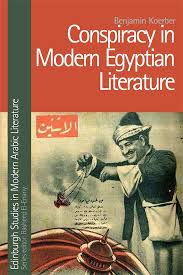
This article was last updated on April 16, 2022
Canada: ![]() Oye! Times readers Get FREE $30 to spend on Amazon, Walmart…
Oye! Times readers Get FREE $30 to spend on Amazon, Walmart…
USA: ![]() Oye! Times readers Get FREE $30 to spend on Amazon, Walmart…
Oye! Times readers Get FREE $30 to spend on Amazon, Walmart…
In Benjamin Koerber’s Conspiracy in Modern Egyptian Literature, Egyptian literary paranoia and conspiracy theories — from the mid-20th century until now — are treated in detail:
By Tugrul Mende
Conspiracy in Modern Egyptian Literature, Benjamin Koerber, Edinburgh: Edinburgh University Press, 2018. 235 pp.

Conspiracy stories are not a rare phenomenon. They can be found all over the hich orld, and they swirl around events from the moon landing to 9/11. It is a feature of human thought that is discussed in various shapes and forms, sometimes sarcastically, sometimes more seriously. It is part of literature as well, as Benjamin Koerber shows in his book Conspiracy in Modern Egyptian Literature.
Detailing the concept of conspiracy theory, Koerber explains how it has manifested in Egyptian literature starting from the mid 20th century to the present day. He invites us to read Egyptian Literature from the angle of conspiracy theories, which in his simplest definition can be seen “as a narrative that reduces politics and history to the machinations of an omnipotent, transhistoric entity, such as Zionism, Freemasonry, the Knights Templar, or the like“ (4-5). Later, he breaks it down to very specific concepts and definitions, and this narrative of conspiracy theory is found in many shapes and forms in Egyptian literature. Koerber makes his case by using literary forms found in theatre, prose, experimental literature, and autobiographical works. By discovering, rediscovering, and interpreting classics and new novels such as Sonallah Ibrahim’s Al-Lajna (The Committee) and Ahmed Naji’s Istikhdam al-Haya (Using Life), he takes us on a journey through literary works that “have not previously been associated with conspiracy theory.“ (11)
By working through the narrative of conspiracy, and the political and social dimensions in which the works find themselves, Koerber explains in five chapters how literary structures are connected to conspiracy theory, and in which ways they are manifested in the Egyptian literary scene. The book starts from showing “how modern stage theatre, in its arrangement of actors and audience, accords with the representational structure conspiracism“ (23) and apocalyptic scenery found for example in Mohammad Rabie’s ‘Am al-Tinnin (The Year of the Dragon) attend “to conspiracy theory in a playful manner.“ (25) While Koerber is reluctant in categorizing the literary scene, it is possible to mention that each work in his book has its own characteristics and different features closely connected to conspiracy theory.
Starting from the early 1950s and 60s, theatre was an important place where performances were used to reflect the state in which Egyptian intellectuals and personalities were living. Ali Ahmad Bakathir (1910-1969) and Yusuf Idris (1927-1991) are the main features in the first chapter “Dramaturgies of Conspiracy: Bakathir, Idris and the July Regime,” in which the relationship between these two in accordance to the state, society, and political life are reflected in their works through the prism of conspiracy, using his work as a political commentary on the issues at hand. By reading his plays, Koerber shows us “conspiracy theory in its ‘pure‘ form.“ (34).
Tracing conspiracy in Egyptian literature continues in the second chapter entitled “Naguib Surur: The Poetics and Politics of Niyaka” which centers on the poems of Surur, whom he calls “perhaps the most paradigmatic conspiracist figure in modern Egyptian literature.“ (23). In his poems, Koerber examines those features which resulted from the author’s “years of exile, rejections, illness, and loss“ (59). Also, the figure of Naguib Surur is closely linked to his work and how the context and his prose are connected with each other and are multi-dimensional. Koerber concludes that the “sources and functions of Naguib Surur’s conspiracist poetics are multitude and intertangled“ (93). From working on poetry and theater, Koerber moves on to more contemporary works, and he re-reads works that are now considered classics by Sonallah Ibrahim and Gamal al-Ghitani.
A phenomenon which was dubbed as the authoritarian turn of some authors is used as a framework on how sometimes opinions and views by some are changed in the context of the authors’ support for the new regime (94-95). This is the starting point for the next chapter, where Koerber rereads Sonallah Ibrahim’s famous book al-Lajna (The Committee), which was published in 1981 and is considered one of the milestones in Ibrahim’s career and often is paired with Kafkas’ The Trial. He “reads the novel as a cautionary tale about the perils and pitfalls of a particular mode of hermeneutic suspicion that has much in common with what we have been calling conspiracism.“ (95). By analyzing how suspicion and paranoia find its way into this classic, he concludes that: “The ‘authoritarian turn’ is not a turn at all, but a consistent and logical denouement for the narrative of conspiracy and suspicion.“ (115).
Chapter four “Gamal al-Ghitani’s Hikayat al-Khabi’a: The Fitna of Sexual Deviance” concentrates on the late author’s work, although Koerber discusses Muhammad Abd al-Nabi’s Fi Ghurfat al-´ankabut (In the Spider’s Room) (2016) as well, because as Koerber states “the ‘(sexual) deviant‘ (al-shadhdh) – in particular, the homosexual or effeminate man – has long featured as a trope of considerable potency in conspiracy theories and paranoid plots“ (119). He continues discussing the relationship “between paranoia and homosexuality“. This brings to mind the episode that followed Mashrou‘ Leila’s performance in Cairo last year, when a wave of arrests occurred because of hatred and paranoia. It resulted in the banning of Mashrou’ Leila in Egypt. The books in this chapter have a feature called panic, anxiety that finds its equivalent in the US as well. While concentrating on these aspects, and focusing on investigations of them, it “allows us to enrich our understanding of complex events by adding previously neglected motives and mechanisms to an ever-evolving narrative of (literary) history“ (141).
The literary scene’s connection with the conspiracy theory didn’t appear from nowhere in the context of the 2011 revolution. A group of authors have dedicated themselves in weaving political and social contexts into their writings, while keeping it experimental and fictional. Ahmed Naji’s Istikhdam al-Haya (Using Life), which Koerber translated into English, is one of the books that are analyzed in the last chapter. Many scholars and activists have written articles in solidarity with Ahmed Naji, who was jailed for two years after publishing parts of this book in Akhbar al-Adab magazine. Teresa Pepe, a scholar from the University of Oslo wrote an article titled “Literature is on trial in Egypt,” in which she tries to defend the author by stating that: “by reading the novel as a whole, one understands that it is not only about sex and drug use. The Use of Life is a hybrid work between an ordinary novel and a graphic novel, as it includes prose by Naji and drawings by Egyptian cartoonist Ayman Zorkany.“
In a campaign entitled “Egypt: Art on Trial,” many novelists supported the cause of defending Ahmed Naji and his novel. In one video, Sonallah Ibrahim says that “the ruling is part of a raging battle in the public sphere where we see the brutality of groups in authority, the judiciary and the different state bodies nestled in the Ministry of Interior as well as the legislator and all other places.“ Discussing experimental books and new forms of novels, its emphasis is on the “experiments in irony, or parodical imitations of predecessors and contemporaries in literature and society“ (143-144). He emphasizes again that the works in question are not “political manifestos, but literary experiments that entangle the reader in labyrinthine plot-lines and multiple modes of existence, feeling and thought“ (168).
The only woman the author discusses, who he also acknowledges in the introduction, is Radwa Ashour. By reading Ashour’s work, the author remarks that “conspiracism, or waswasa, alerts us to lurking dangers, but it also constitutes a danger in and of itself“ (173). Concluding with the words of Koerber, the book is a reminder and an invitation at the same time: “Reading with charity may prove more rewarding than reading with suspicion.“ (169). Koerber has opened up with his work a new way of reading modern Egyptian literature, which should be further explored in the future.
Tugrul Mende holds an M.A. in Arabic Studies from the University of Leipzig. He is from time to time writing for online magazines such as Mada Masr and Qantara.
Click HERE to view more.
You can publish this article on your website as long as you provide a link back to this page.

Be the first to comment